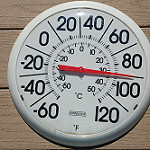 This article was written by Beth Englezos, Program Manager for Secure@Home
This article was written by Beth Englezos, Program Manager for Secure@Home
In case you haven’t been outside yet…it’s HOT! JFCS wants to give you some information that we’ve gathered on staying cool and well during these dog days of summer.
Did you know that many municipalities will open cooling centers? Call your local government office or library to find out more.
BASIC TIPS TO KEEP COOL:
- Wear lightweight, light colored, loose fitting clothing that covers the skin as much as possible.
- Avoid strenuous activity, especially during the sun’s peak hours, 11 AM to 4 PM.
- Drink fluids, particularly water, even if you do not feel thirsty, avoid beverages containing alcohol, caffeine, or high amounts of sugar.
- Never leave children, the elderly, or pets alone in closed vehicles.
- Provide plenty of cool fresh water for your pets and remember to keep them indoors and out of the sun
Avoiding Heat Exhaustion
According to the U.S. National Institute on Aging, the risk of heat related illnesses such as heat stroke and heat exhaustion increases with age. Researchers explain that as people get older, they are less able to adapt to high temperatures, and heat might exacerbate any medical conditions they have. In addition, older adults might develop certain health problems that could increase their risk of hyperthermia (when the body overheats).
These medical issues include:
- Congestive heart failure, diabetes and chronic obstructive pulmonary disease
- Trouble walking or moving
- Dementia or problems with cognition
- Dehydration
It is important to note that medications may cause dehydration or affect the ability of their heart, blood vessels or sweat glands to respond to the heat. Environment can also influence a person’s response to the heat. For instance, not having access to air conditioning or transportation, or overdressing could put them at greater risk for heat-related illnesses involving hyperthermia, including heat fatigue; heat syncope (lightheadedness or fainting in the heat); heat cramps; and heat exhaustion. Heat stroke (an advanced form of hyperthermia) sets in when the body’s temperature hits 104 degrees F.
The following are signs of heat stroke:
- A strong, rapid pulse
- Lack of sweating
- Dry, flushed skin
- Faintness
- Staggering
- Change of mental status, including confusion and disorientation
If it is suspected that someone is suffering from a heat-related illness, you are advised to take the following steps:
- Call 911 immediately.
- Move them into air conditioning or other cool place.
- Urge them to lie down and rest.
- Remove or loosen tight-fitting or heavy clothing.
- Encourage them to drink water or juices if they are able to drink, but avoid alcohol and caffeine.
- Apply cold water or cold compresses to their skin.
OTHER TIPS FOR KEEPING COOL!
Here are some tips for keeping cool from WikiHow.
- Put a small pillow in the freezer an hour or two before you go to bed. Put a few plastic shopping bags over it to keep ice from forming on the fabric.
- Use silk or satin pillowcases, and satin sheets. These fabrics will feel smoother and cooler as you sleep.
- Add mint leaves, or orange, lemon or cucumber slices to your water to make it more refreshing.
- Get a cheap spray bottle – fill it with water, adjust it to fine mist and spray it on your exposed skin for an instant chill-zing cooling effect.
- Keep the back of your neck in shade (wear a cap backwards, or raise your collar) or put a wet handkerchief on the back of the neck. The sensor for our body temperature control system is in this area, and so with this method you can make the rest of your body think that you are “cool”.
- Place or tie an icepack behind your head.
- Wet all your hair, or just all along the hairline in a pinch. The evaporation of the water will cool your head (though it may make your hair a bit frizzy if it’s curly!).
- Wear a bandana with water soaked on it and put it on your head. Or you can relive the 80’s and wear a wet terry cloth headband on your forehead.
- Try using a water misting fan. These portable devices are battery operated so you can take them with you wherever you go. As you mist and fan yourself, the water is evaporated on your skin, giving you an instant cooling sensation.
- Run cold water over your wrists for 10 seconds on each hand. This will reduce your temperature for roughly an hour.
- Soak your feet in a bucket of cold water. The body radiates heat from the hands, feet, face and ears, so cooling any of these will efficiently cool the body. Kids wading pools are great for adults feet too.
- Fill your bathtub with cool water and get in. Once you are used to the temperature, let some water out and refill with cold water. Keep doing this until you are sufficiently cold. Your body will stay cool for a long time after you get out. For a fast cool-down, add ice!
- Wear light colors. Darker colors will absorb the sun’s heat and stay warmer longer than light or white clothing, which reflects light and heat. Wear natural summer clothing.
- Stock your freezer with flavored ice treats. Freeze a bag of chopped fruit such as watermelon, pineapple or lemons. Cooling down can be a tasty experience too!
- Use cucumbers. Slice a thin piece of cold cucumber (from the fridge or a cooler) and stick it in the middle of your forehead! This feels fantastic on a hot day or when stuck in a hot car and works almost immediately! An ice cube or a cold soda can work similarly, though the astringency of the cucumber is more refreshing for your eyelids.
- Think cool. Read books about climbing Mount Everest, visiting Norway, or watch winter movies like “March of the Penguins” and “Ice Age.” You might not be physically cooler, but if your mind envisions a cold environment, you might feel a bit cooler.
- Sit still. Do not try to fan yourself – trying to move while feeling hot can make you feel hotter. Simply rest until the evening.
- Set up a water misting system that connects to an ordinary garden hose that can be found at home improvement stores. Sit there and let the mist cool you off.
For the complete list, see the original article at http://www.wikihow.com/Cool-Yourself-Without-Air-Conditioning


